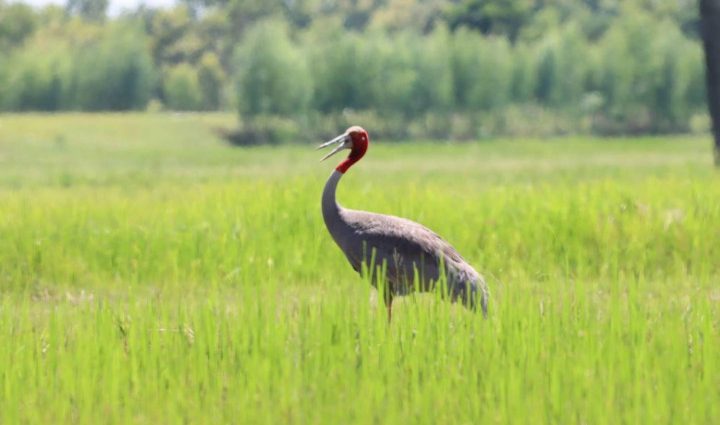PUBLISHED : 20 Aug 2023 at 05:25

The discovery of Eastern Sarus Crane eggs in a rice field next to the Huai Talat Reservoir Non-Hunting Area in Buri Ram’s Muang district is a positive sign that conservation efforts are paying off, says the Department of National Parks, Wildlife and Plant Conservation (DNP).
The department on Friday posted photos and a story on the discovery of the two eggs. It said the owner of the farm contacted wildlife officials, who recorded the location and asked for cooperation from the community in avoiding disturbing the bird’s habitat.
Phadet Laithong, director of the Wildlife Conservation Office of DNP, said the discovery of the eggs is good news, hailing the success of the department’s wildlife project.
Sarus cranes, commonly known as Thai cranes, have grey plumage, long legs, a long neck and a sharp beak, he said. The upper part of the neck and lower part of the head is red while the top of the head is bare, and they have round, dark orange eyes, he said.
The birds were last seen in the wild about 50 years ago and were believed to be close to extinction in Thailand until the DNP worked with the Zoological Park Organization to release the cranes into nature, he said.
Wildlife authorities released 10 Sarus cranes into the Huai Chorakhe Mak Non-Hunting Area in 2011, he said.
“The discovery of the nest is an important message that the project is increasing the Sarus crane population in their natural habitat,” he said.
“Although the bird population is small it has a good chance of survival, as long as there is strong cooperation from stakeholders, including communities around non-hunting areas.”
One task under the Sarus crane conservation project involves promoting organic rice plantations to reduce the risk of bird death by harmful chemicals in paddy fields, he said. The jasmine rice that grows in the natural habitat of Sarus cranes is packed and sold under the “Sarus Rice” brand, he said.
According to the Zoological Park Organization, 156 Sarus cranes have been released to the wetlands in Buri Ram since 2011. As of today, the organisation has recorded about 120 Sarus cranes living in nature, the source said, adding the population trend is likely to increase. It is among 15 species listed in the 1992 Wildlife Protection Act.

